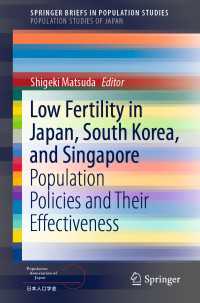Description
This volume investigates the "global education effect"—the impact of global education initiatives on institutional and individual practices and perceptions—with a special focus on the dynamics of border construction, recognition, subversion, and erasure regarding "Japan". The Japanese government’s push for global education has taken shape mainly in the form of English-medium instruction programs and bringing in international students who sometimes serve as a foreign workforce to fill the declining labour force. Chapters in this volume draw from education, anthropology, sociology, linguistics, and psychology to examine the ways in which demographic changes, economic concerns, race politics, and nationhood intersect with the efforts to "globalize" education and create specific "global education effects" in the Japanese archipelago.
This book will provide a valuable resource for anyone who is interested in Japanese studies and global education.
Table of Contents
Series Editors’ Foreword List of figures List of tables Part I Settings Chapter 1. Introduction: Borders, Japan, and Global Education Effect (Neriko Musha Doerr) Chapter 2. Tracing the Developments of the “Global Education Effect” in Japanese Higher Education: Discourses, Policy, and Practice (Gregory Poole, Hiroshi Ota, and Mako Kawano Chapter 3. Japan’s New “Immigration” Policy and the Society’s Responses (Uichi Kamiyoshi) Part II Tracing Effects Chapter 4. “Ryūgakusei” as Students, Workers or Migrants? Multiple Meanings and Borders of the International Students in Japan (Miloš Debnár) Chapter 5. Global Education’s Outcomes and Improvement: The Role of Social Markers of Acceptance in Constructing Japanese Identity and Ingroup Boundaries (Adam Komisarof) Chapter 6. “Post Study Abroad Students,” “Never Study Abroad Students,” and the Politics of Belonging: The Global Education Effect of Japan’s English-Medium Campus (Neriko Musha Doerr, Gregory Poole, and Roy Hedrick III) Chapter 7. Translanguaging Practices within an Ideology of Monolingualism: Two Autoethnographic Perspectives (Ngọc Anh Đỗ and Gregory Poole) Part III Projects for Transformation Chapter 8. Refracting Global Imaginations through Collaborative Autoethnography and Teaching: Reflections from Two “Border Crossing”/“Returnee” Academics in Japan (Yuki Imoto and Tomoko Tokunaga) Chapter 9. “The Sea”: Benefits of Discussing Controversial Issues in Second/Foreign Language Teaching (Saeri Yamamoto) Chapter 10. “Ekkyō bungaku” as crossing the border of language: Implications for learners of Japanese (Yuri Kumagai) Chapter 11. Use of the Border Dynamics for Educational Purposes (Yuko Abe) Chapter 12. Conclusion: Global Education Effects and Future Directions (Neriko Musha Doerr) Index
-

- 電子書籍
- 量販トイスクラップー売る人と買う人の話…
-

- 洋書電子書籍
- 松田茂樹(編)/日本・韓国・シンガポー…
-

- 洋書電子書籍
-
暴政の歴史:権力、不正義とテロ
…
-

- 洋書電子書籍
-
精神生理学ハンドブック(第4版)
-

- 洋書電子書籍
-
誰もが知っておきたいポルノ産業
…



